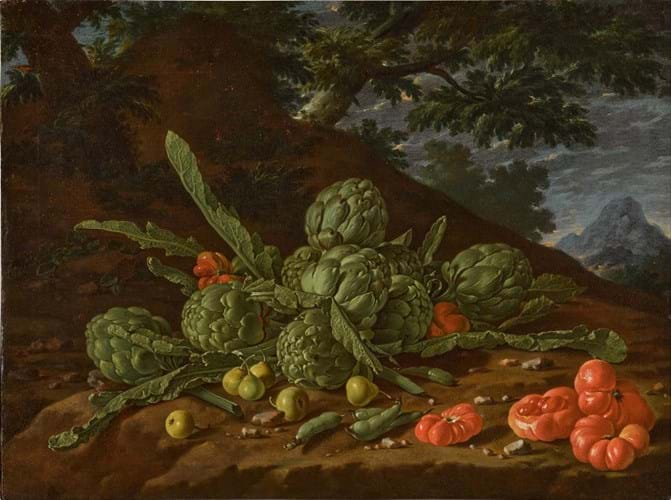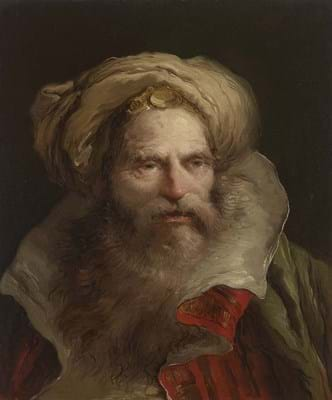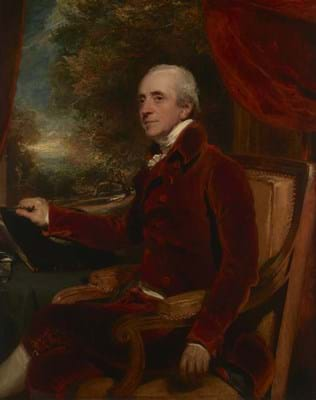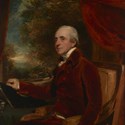
Saint Agricius of Trier and Saint Anno of Cologne by The Master of the Agilolphus Altarpiece, $900,000 (£708,660) at Sotheby’s.
The difficulty in sourcing high-quality and market-fresh material has become a standard refrain in the Old Master market.
After a decent uplift in the first half of 2023, supply issues once again loomed large at the two most recent auction series in London and New York.
Following a relative flat series in London in December punctuated by a few strong contests for unusual or quirky subjects (see ATG No 2624), the lack of stand-out lots was again somewhat acute at the latest sales in the Big Apple held at the start of 2024.
The auctions were not helped by the withdrawal of a Diego Velázquez (1599-1660) portrait depicting Isabel de Borbón, Queen of Spain, which was due to be offered at Sotheby’s with an estimate ‘in the region of $35m’.
Christie’s also had a number of lots withdrawn including a pair of Michele Marieschi (1710-1743) vedute which had an estimate of $2m-3m.
Of the remaining lots, a significant proportion were unsold including the potential best-seller: Self-Portrait of the Artist as a Young Man by Sir Peter Paul Rubens (1577-1640), guided at $3m-5m at Sotheby’s. The failure of few other big-ticket lots as well as a number selling on or below their low estimate also hardly either engendered confidence or helped the bottom line.
Unstable world
Were global factors also at play? One leading dealer told ATG that the upcoming elections in the US and UK and wars in Ukraine and Gaza were not conducive to a general climate of buying and selling.
Another mentioned the fact that the estimates here were often too high for the market to absorb.
On the demand side, a reduction in Asian and Russian buying also appears to be hitting the sector, while the trade remained pretty selective when it came to bidding.
The final tally for the New York Old Master sales at Sotheby’s and Christie’s at the end of January and early February was $60.3m (£47.5m) including premium. This compared to the record $171.5m (£139.4m) from the equivalent series last year where a bumper crop of consignments came forward – not least the single owner sale of works from the JE Safra collection offered at Christie’s and 10 pictures from the Fisch-Davidson collection at Sotheby’s that raised a cool $49.6m (£40.3m) on their own.
Speaking about the latest series, London dealer Johnny van Haeften told ATG: “There wasn’t a lot there. Because of the relative paucity of the lots on offer, many people didn’t bother to go, so there were a few bargains for those who made the journey.
“The good things did well but there was little or no demand for the second and third tiers. It’s what we’ve been seeing for some time, the best and the rest. The market is polarising, naturally, but there’s still life at every level, even if it’s becoming more selective.”
Stretching the boundary
The top picture at the current series wasn’t even technically an Old Master. Gustav Bauernfeind’s (1848-1904) The Western Wall, a large-scale view of the holy site in Jerusalem which was consigned to Sotheby’s by a West Coast Jewish institution, sold for $2.8m (£2.21m) against a $2m-3m estimate.
It is not uncommon these days for such leading Orientialist pictures to appear alongside Old Masters at auction (the latter category traditionally defined as continental European pictures from before 1800).
That being so, the top Old Master of the New York series came at the same Sotheby’s sale: a rediscovered self-portrait by Sir Anthony van Dyck (1599-1641) that made a low-estimate $2m (£1.58m) – see report in ATG No 2629.
While some of best competition came among the works on paper on offer, only a smaller number of paintings seemed to capture the imagination.
One of the exceptions to the rule was the strenuous bidding battle that came for a striking panel from a German altarpiece that had been restituted to the heir of Jacques Goudstikker, an Amsterdam-based dealer and collector from whom over 1400 were appropriated during the Nazi invasion of the Netherlands.
Over the years, numerous works have been restored to the family in part thanks to the remarkable survival of Goudstikker’s black notebook in which he itemised every work in his vast stock. Sotheby’s has sold a number of them in recent years, including an Adam van Breen (1590-1645) winter landscape that made £138,600 including premium in London in 2022.
The current picture, which was offered at Sotheby’s Master Paintings and Sculpture Part 1 sale on February 1, had been restituted somewhat earlier. It was one of 200 pictures that been held by the Dutch state since 1946 and were handed back after a landmark ruling in 2006.
Nevertheless, there was still a sense of excitement as the depiction of Saint Agricius of Trier and Saint Anno of Cologne emerged for sale.
Measuring 7ft x 2ft 3in (2.15m x 70cm), the oil on panel was created in Antwerp in c.1520 and was originally one of the outer wings of a large and complex altarpiece that was exported to the Rhineland for the church of St Maria ad Gradus in Cologne. In 1817, the altarpiece moved to the nearby Cologne Cathedral, at which time the outer wings were removed and dispersed.
The artist who painted it is most often referred to as The Master of the Agilolphus Altarpiece. Although anonymous, the hand is identified as having painted a number of major works in the ‘Antwerp mannerist’ style in the early 16th century. This was first time in living memory that an example had appeared at auction.
Even if there was little precedent to go on in terms of price, the $300,000-500,000 estimate did not seem excessive to a number of parties who deemed it a remarkably bold, vibrant, detailed and rare painting in its own right, as well as being part of an important late Gothic altarpiece.
After strong competition, it was knocked down at $900,000 (£708,660).
From the same source came another large-scale panel restituted in 2006. Triumph of Lucius Aemilius Paullus after the Battle of Pydna by Giovanni di ser Giovanni Guidi, the Florentine artist known as Lo Scheggia (1406-86), fared rather differently, however. It sold at $650,000 (£511,810) against an estimate of $1m-1.5m, underlining the market selectivity.
Another of the lots at Sotheby’s with high expectations which met with a somewhat muted reaction was a rare picture by the Spanish artist Luis Meléndez (1716-80).
The still-life showing artichokes and tomatoes in an atmospheric rocky landscape had a surrealist air to it but some parties may have deemed it a bit over-elaborate.
Although he painted more than 100 still-lifes throughout his career, Meléndez produced only six large-scale examples with outdoor settings such as this.
Any work by Meléndez is uncommon at auction, with Artprice.com recording just 38 auction results.
The 2ft 1in x 2ft 9in (62 x 83cm) oil on canvas here, which was signed L. Mz to a small stone to the right of the picture, came from the estate of renowned New York dealer Herman Schickman who died in 2007. Christie’s had sold a selection of over a dozen works from his collection in 2018-19 and he had acquired this one from London’s Hallsborough Gallery sometime before 1970. It had since been on loan at New York’s Metropolitan Museum of Art from 1999-2018. The estimate was $2m-3m, perhaps a reflection of the fact that the artist had broken the £3m barrier at Christie’s in 2012, although that lot was a still-life on a dark background and was compositionally and atmospherically rather different.
Sotheby’s was clearly hoping for some cross-over interest with the catalogue pointing to how the ‘graceful simplicity’ of Meléndez’s work ‘is so appealing to the modern viewer, raised on the beautifully constructed compositions of Cézanne and Matisse’.
This failed to lead to the hoped-for bidding battle, however, and it sold below estimate at $1.65m (£1.3m), a result that nevertheless represented the third-highest price for the artist at auction.
Overall, Sotheby’s flagship auction of the week raised $21m with 30 out of 49 lots sold (61%).
Gentileschi in demand
Christie’s main Old Master sale on January 31 also had its fair share of unsolds with 42 of the 78 lots finding buyers (59%). The hammer total of $10.9m (£8.62m) came in well below the $18m low estimate for the sale.
The top lot was a vibrantly coloured panel painting also by Lo Scheggia (1406-86). Offered with a third-party guarantee, it just tipped over the $1.2m low estimate and sold at $1.25m (£984,000). The vendor had paid £850,000 for it at Christie’s in London in 2010.
The work itself was a cassone front (a panel for an Italian marriage chest) and depicted a scene based on the story of Coriolanus. Measuring 16¾in x 5ft 1in (43cm x 1.55m), it had previously been ascribed to various other Florentine artists but since the 1990s had been reattributed to Lo Scheggia and was deemed among his most impressive works as a painter of this type of panel.
Perhaps the most eyecatching bidding battle came for a recently discovered painting of Saint John the Baptist in the Wilderness.
It had been acquired by the vendor in 2021 at an auction in Naples where it was described as simply ‘Neapolitan School, first half of 17th century’ (ATG could not trace the hammer price).
Here its attribution was significantly upgraded and it was offered as an autograph work by Artemisia Gentileschi (1593-1654) – a female Old Master artist much in demand at present.
The 3ft 11in x 3ft 2in (1.2m x 97cm) oil on canvas was said to compare closely with other firmly attributed works by the artist from the mid-1630s, in particular a signed painting of Minerva now in the Uffizi in Florence.

Saint John the Baptist in the Wilderness by Artemisia Gentileschi, $780,000 (£614,175) at Christie’s.
Christie’s catalogue pointed to four scholars that had endorsed the attribution (three from first-hand inspection).
This clearly gave confidence to bidders and, pitched at $400,000-600,000, it was knocked down at $780,000 (£614,175) to an online buyer. Six years ago this would have been a record price but, due to the expansion of the artist’s market over recent time, now it was only the eighth highest according to Artprice.
Two intriguing portraits also sold at Christie’s. One was A bearded man wearing a turban by Giandomenico Tiepolo (1727-1804), probably depicting a philosopher in eastern-inspired dress.
The 2ft x 20in (61 x 50cm) oil on canvas had been acquired by the vendor after it appeared with a £60,000-80,000 estimate at a Sotheby’s auction in 1990.
Here it was expected to fetch a lot more. Estimated at $700,000-1m, it sold at $750,000 (£590,550) –a substantial return for the vendor (even accounting for inflation) and seemingly reflective of the demand on the current market for works with subjects that reference cultural identity in some way.
The other lot was a quality example of British portraiture: Sir Thomas Lawrence’s (1769-1830) portrait of the MP William Baker. The sitter’s mother came from a publishing family and he himself built an impressive library at Bayfordbury House in Hertfordshire, which may explain why he was shown holding a book in Lawrence’s 4ft 3in x 3ft 4in (1.3 x 1.02m) oil on canvas.
This three-quarter-length portrait was in many ways highly characteristic of the artist’s portraits from the first decade of the 19th century, especially the gestural brushwork, colouring and sense of bravura. Unusually though, it was signed and dated by Lawrence.
Although it carries the date of 1807 (on the arm of the chair), he exhibited the picture at the Royal Academy in 1806, something that implied he continued to work on the canvas after the exhibition closed.
The portrait had remained with the sitter’s family until 1953 when it sold at Christie’s, and it was acquired by the vendor from London dealer Noortman & Brod in 1983. Estimated at $200,000-400,000, it sold at $480,000 (£377,955).
Although a decent if not stellar price for Lawrence, it at least showed demand emerging when estimates are more restrained – surely the right approach at times like these when things seem pretty tough for this most traditional of sectors.
£1 = $1.27
Buyer’s premiums
Sotheby’s: 26/20/13.9% + 1% overhead premium
Christie’s: 26/21/15%




















